
Wagwear WagWellies Mojave Dog Boot Review
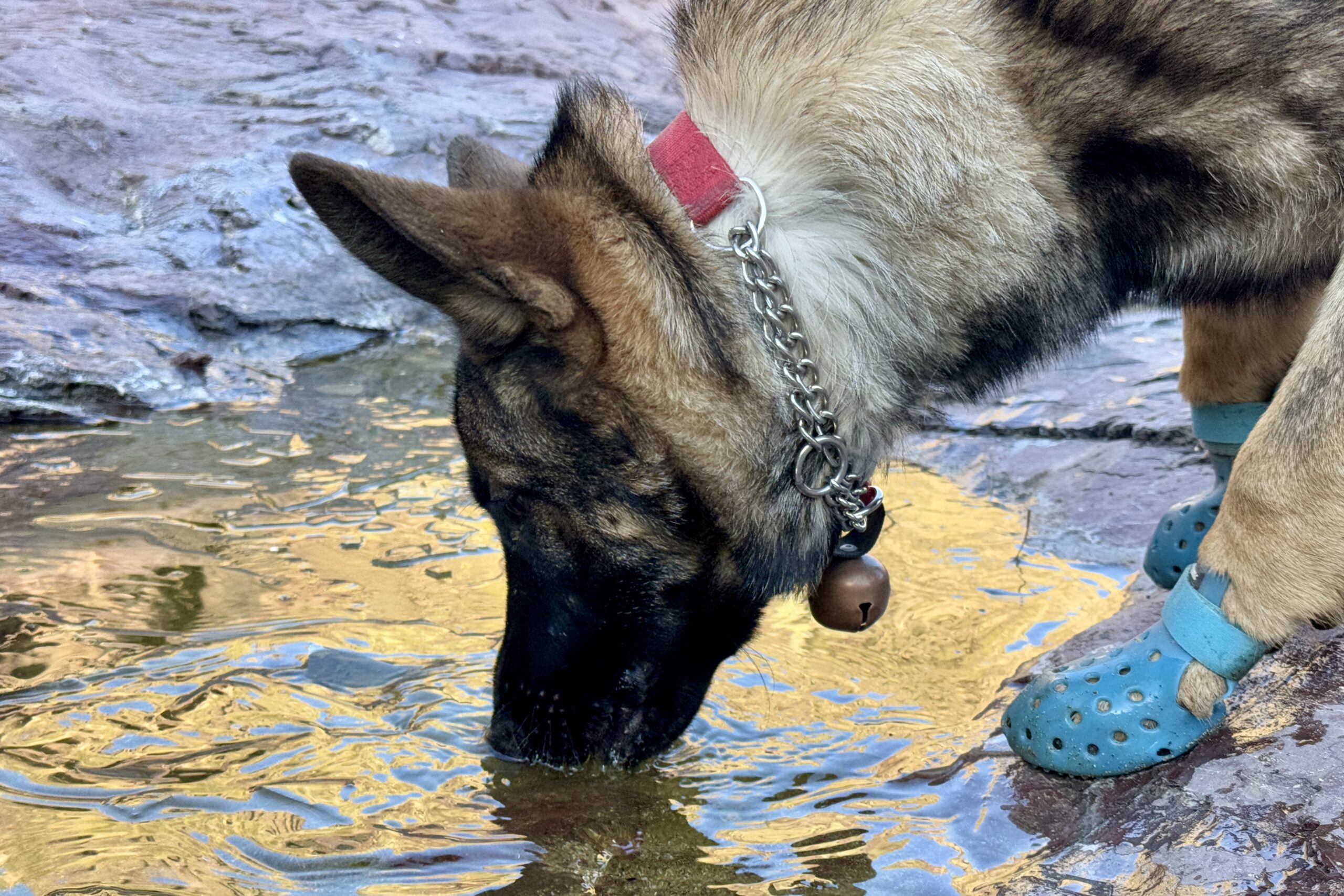
Bottom Line
The Wagwear WagWellies Mojave makes a great choice for general use and hiking, thanks to its unique, rubber, breathable design. We tested ours against other dog boots, and they performed well across the board, landing the top spot on our list of the best dog boots.
Some areas where these dog boots really shine are durability and breathability. Because they are made completely from rubber, they hold up well to hazardous objects and do not absorb moisture. When we poked and scraped these boots, they resisted the objects and did not show any damage. Likewise, the perforated holes allow the feet to vent – though they also provide a way in for rocks and sticks. We were very impressed with how the boot and closure do not interfere with our tester dog’s dew claws. This is one of very few dog boots on the market that have open sides and a high closure. They can also be paired with Wagwarmers to better protect the leg.
We were initially a bit skeptical of the design of these boots, but after our dogs wore them on a backpacking trip in Arizona, we would definitely use the WagWellies Mojave again.
How We Tested
We used the Wagwear WagWellies Mojave boots while backpacking in the Superstition Mountains in Arizona. The trip took place in January, and our tester dog was a young German Shepherd Dog. Part of the hike was on maintained trails, and some was in a wash. We allowed our tester dog to get the boots wet at one point to test the breathability and help identify potential rub spots.
Quick Specs
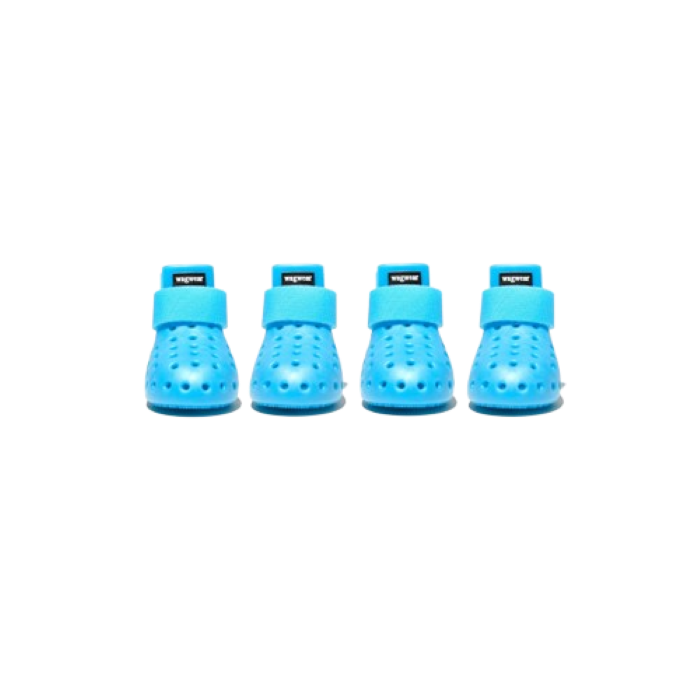
Wagwear Wagwellies Mojave
Best Dog Boot
CleverHiker Rating:
4.5/5.0
Price:
$13
Weight:
1.4 oz
Pros
- Durable materials
- Breathable design
- Dew claw friendly
- Leg liners available
- Thick sole protects feet
Cons
- Holes can get caught on sticks
- Rocks can get in boot easily
- Strap does not attach to front of boot
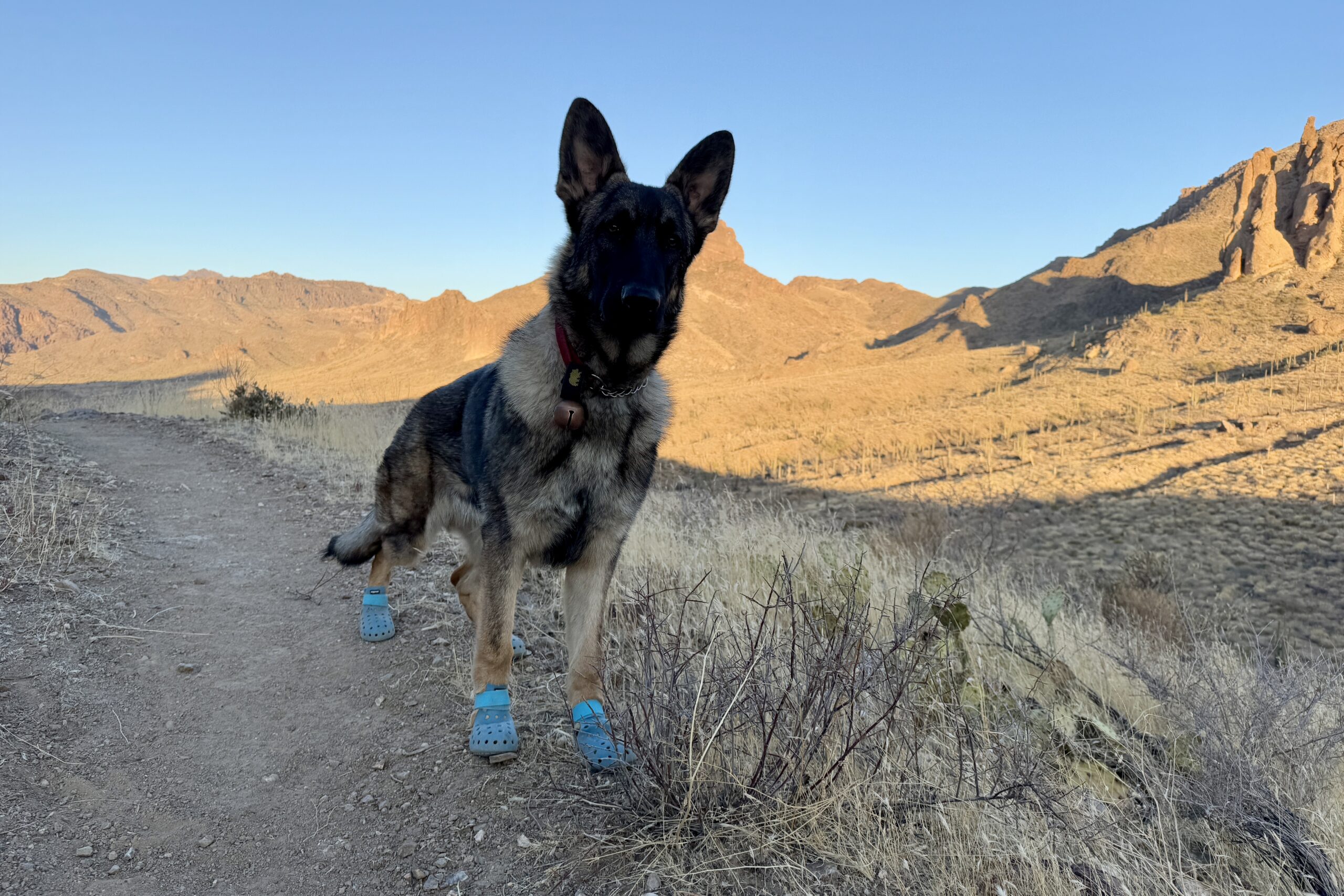
FIT
We love the open-sided design and variety of sizes of the Wagwear WagWellies Mojave boots. At the same time, we wish that the velcro strap looped through the front of the boot.
We gave each boot in our lineup a score for features such as multiple adjustment points, a range of size options, and the option to purchase boot liners. These points – and our experience using the boots – provided the basis of our fit rankings. One thing we really liked about the Mojave compared with other boots is its open-sided design. Many boots cause irritation and sores because they press down on dogs’ dew claws. However, the open side allows the dew claws to breathe, and the velcro attaches securely above the dew claw. This is a game changer for many serious hiking dogs!
Small dog owners know how challenging it can be to find boots for dogs under 20 pounds. We really appreciate that these boots are available in sizes down to ½ inches wide. It would be nice, though, if there were more options for extra large dogs. Wagwear also sells Wagwarmer leg liners that help with long hair, protecting the dew claws and minimizing snow balls from forming.
One thing we would love to see is an update to the velcro strap attachment. While our dogs wore these boots in the Superstition Mountains, we found that sometimes the front of the boot would slip below the velcro, especially on more difficult terrain. This could probably be addressed with a DIY fix, but it would be nice if that wasn’t necessary.
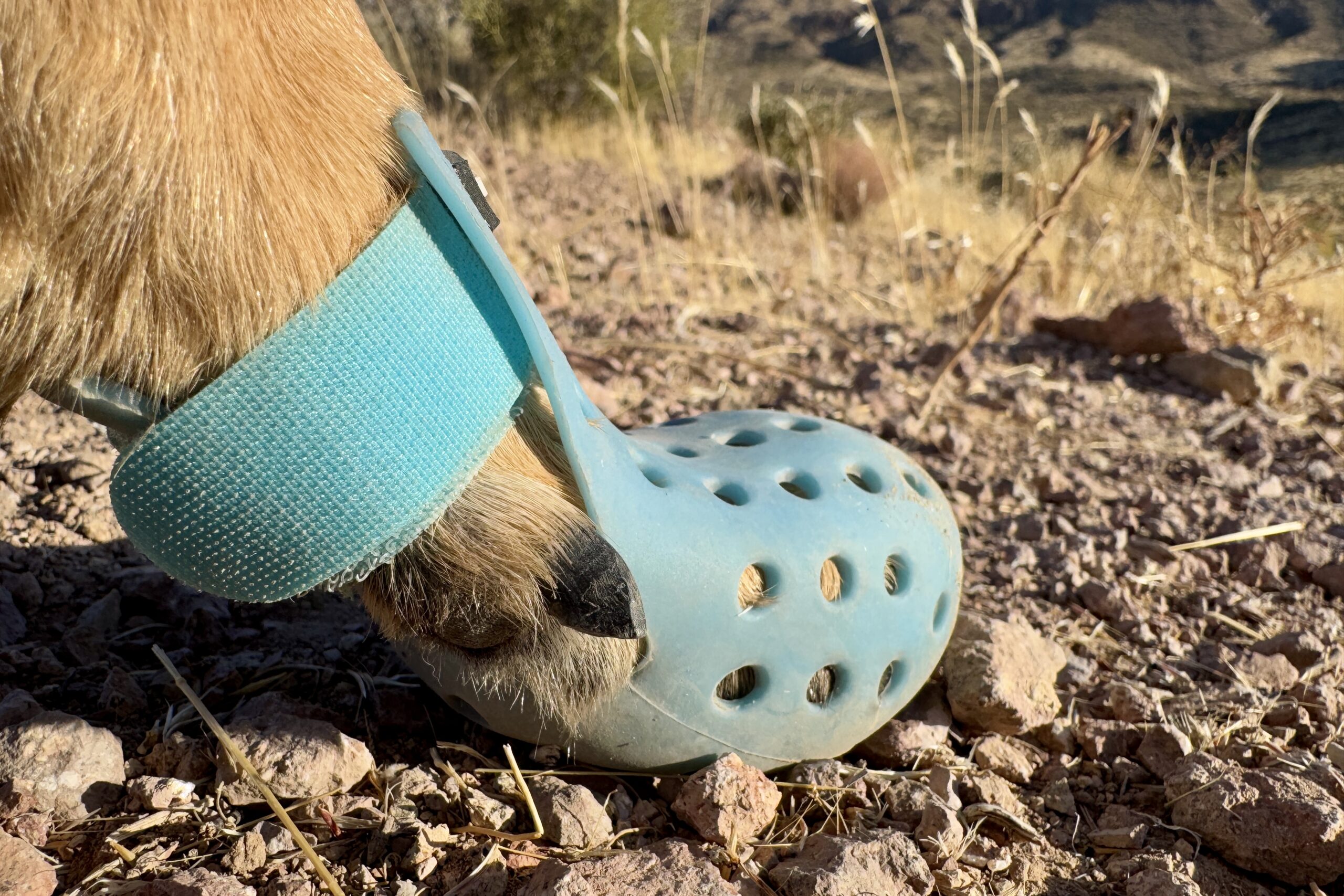
DURABILITY
The all-rubber build of the Mojave boots mean they are extremely durable. Having to replace dog boots frequently – particularly on backpacking trips or thru-hikes – is both inconvenient and costly. Typically, fabric areas of boots wear out long before rubber. Other than the velcro closure, the Mojave boots are completely made of rubber, which means they are built to last a long time.
When our test dog used these on a backpacking trip in the Superstition Mountains of Arizona, we were impressed with how they held up to the rugged environment. Arid deserts, such as the Sonoran Desert of central Arizona, are extremely hard on both dog feed and boots. The dry air causes everything to dry out and crack. The rocky trails wear away at all surfaces, particularly over the course of many miles. At the end of the backpacking trip the tread on the Mojave boots still looked brand new, which is a big testament to their durability. The first failure point on these boots would be where the velcro closure is stitched to the boot. It appears strong and we have not found any evidence of it giving out quickly.
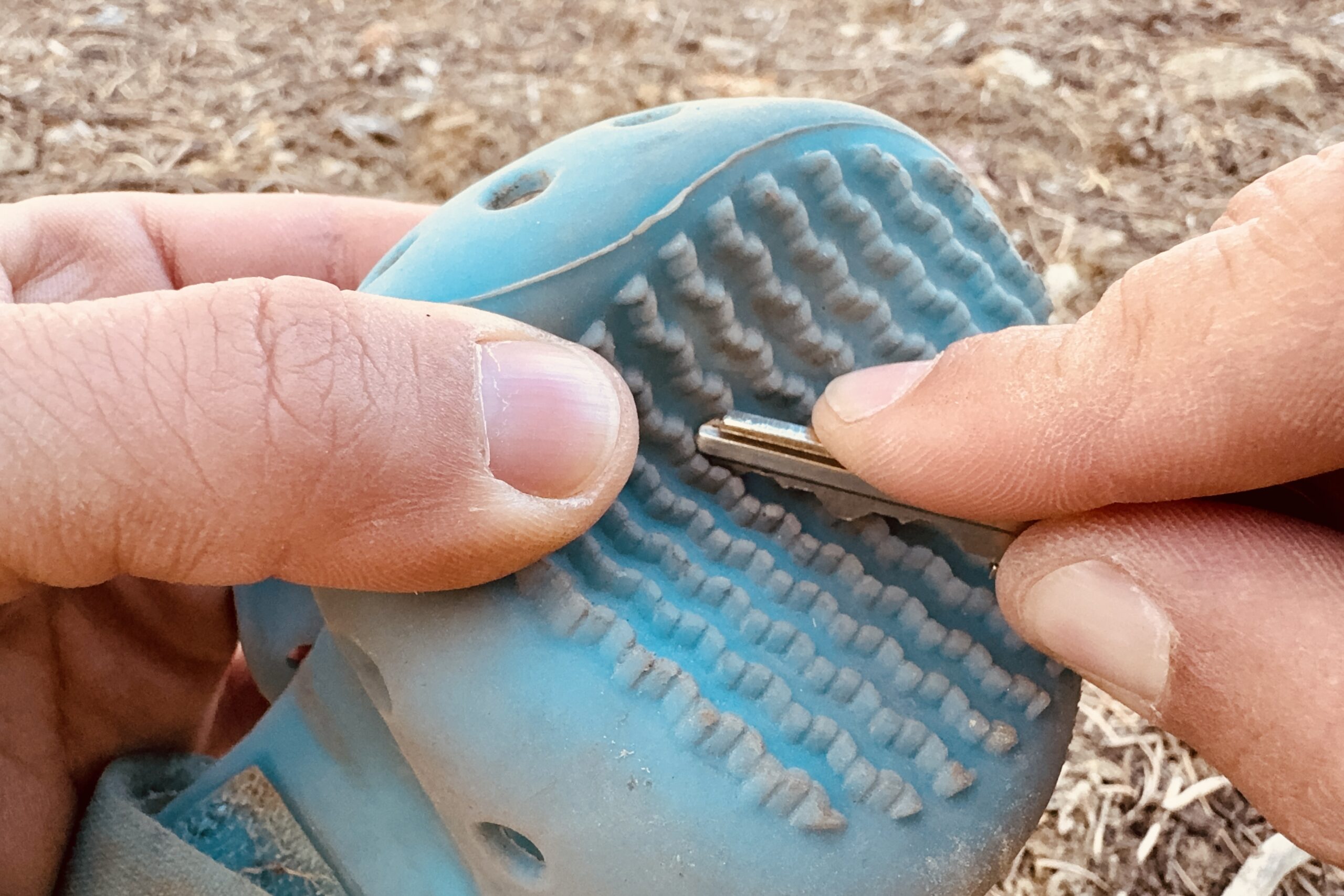
TRACTION
There is dedicated tread on the Wagwear WagWellies Mojave, but it is not as beefy as the tread found on dedicated dog hiking boots. We placed all of the boots in our lineup on our traction testing device. Our traction tester has a lever arm with a rock on the end. We placed each boot on the rock and slowly lifted the lever until the boot lost traction and started to slip. At that point we measured the angle to compare it to the other boots.
The Mojave boots did a good job of clinging to the rock. After the completion of testing we found that it had the fourth steepest angle. There was a bit of a difference between it and our top performers, which is reasonable, given its tread. The Mojave’s tread is not as thick, and the rubber is not as sticky as some of the hiking-specific boots.
On the trail, our tester dog did not appear to have any problems with traction. Even when the boots were wet from standing in a puddle, the dog was able to scramble up some rocks just fine. Hiking off trail up a hillside was no problem either. Because these boots are not well suited for use in snow, we found that the traction is adequate for the average hike.
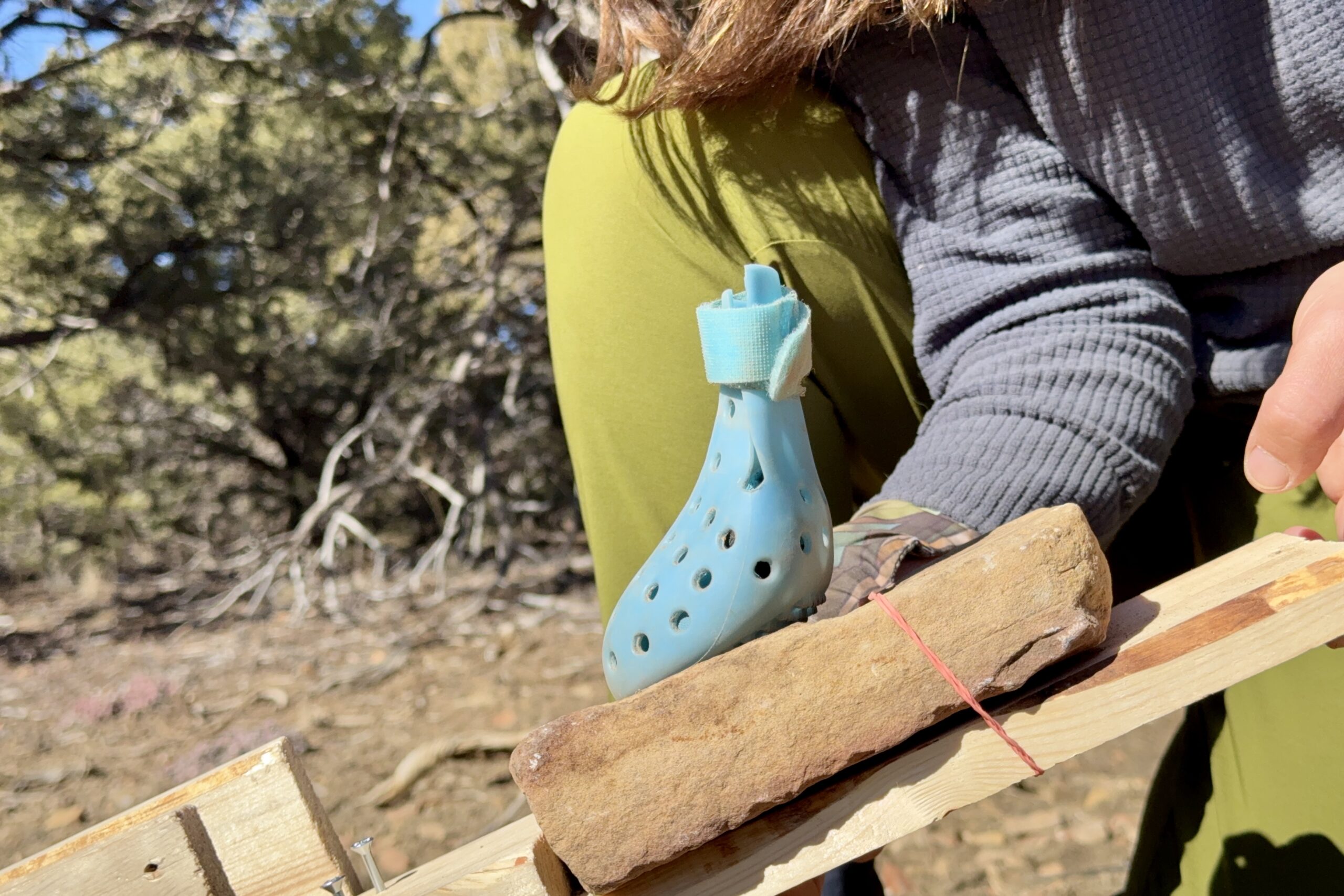
BREATHABILITY
Breathability is a strong area for the Wagwear WagWellie Mojave, thanks to perforated holes in the rubber for ventilation. When we dunked these boots in some water for our comparison test, they were the first to dry. Even in a cold and dark environment, they were ready to use within 10-15 minutes. This is significantly faster than most other boots.
Fully fabric boots tend to dry out faster than boots that contain both fabric and rubber. However, because the Mojave are only made of rubber there isn’t anything to absorb the moisture.
While using these boots in the Superstitions, we purposefully let our tester dog get the boots wet. We wanted to see how well they would breathe and if any sores would form from the moisture. About an hour after getting them wet, we took the boots off our tester dog and did not see any signs of rubbing around the pads. However, we did notice a rub spot above the dew claw where the velcro secures the boot to the leg. This could be easily mitigated by trying to keep the boots dry, using vet wrap, or both.
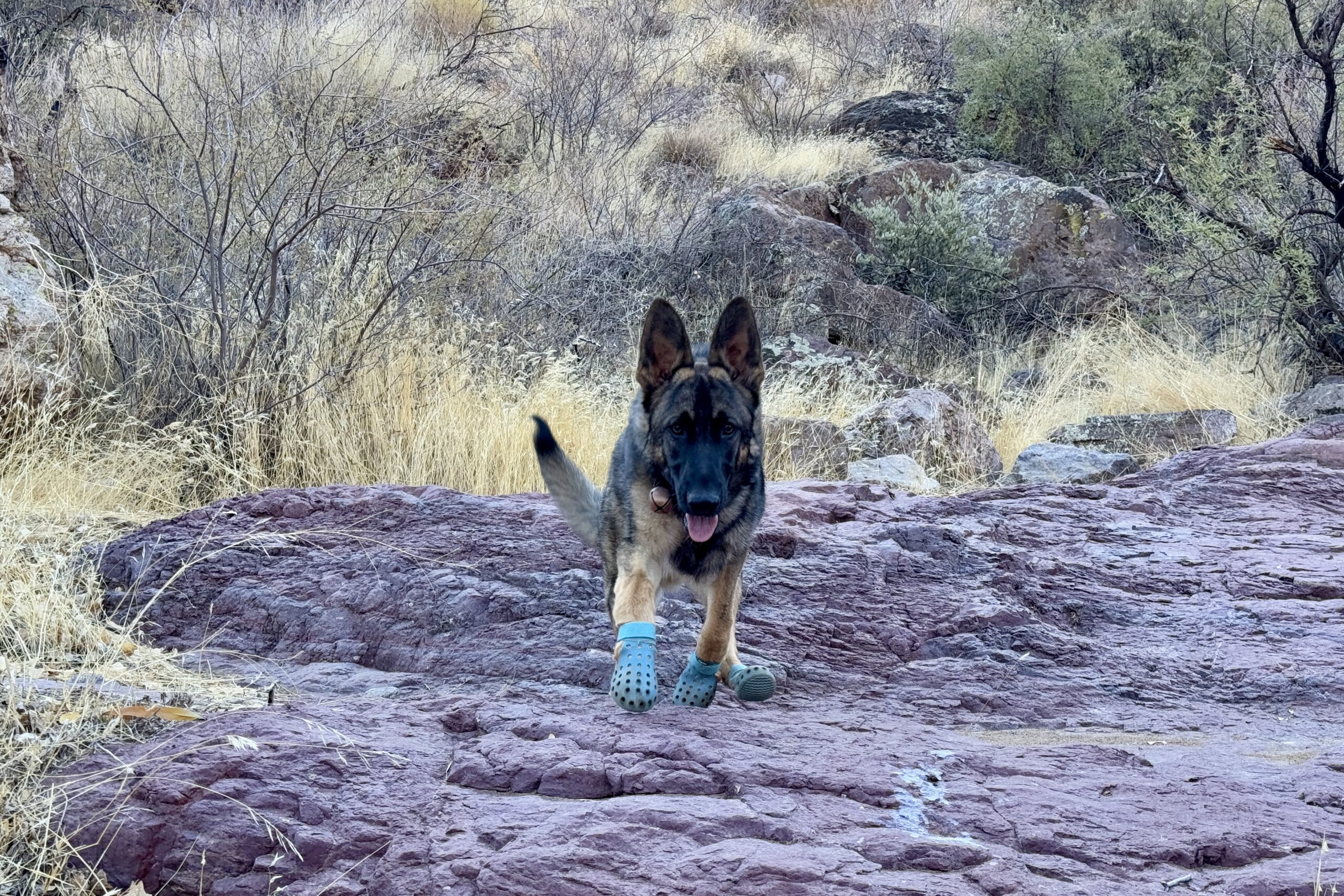
PROTECTION
The Wagwear WagWellies Mojave does an excellent job of protecting pups’ feet from heat, abrasions, and sharp objects. When we tried to cut the boots with a house key and a razor, there wasn’t any observable damage. Likewise, we poked these boots with a knife and a sewing needle. The Mojave boots repelled both objects.
While backpacking with these boots, we found that they do an excellent job of protecting the bottoms of the feet. Our dogs never had any trouble with cactus spines or sharp rocks. That said, the perforated ventilation holes do pose a risk. We had one incident where a small stick got lodged in one of the holes, so we had to stop and remove it. No damage was done, but a dog that races up and down the trail may be at a higher risk for injury. For this reason, we took some points off of the final score for these boots. Overall, they are still one of our top contenders for this category.
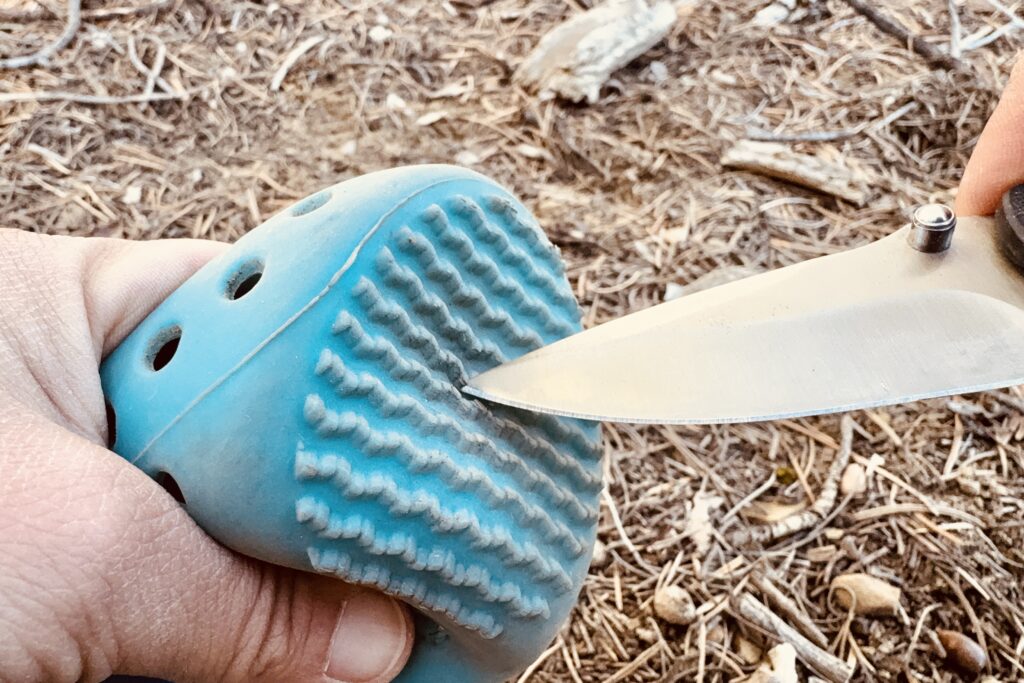
EASE OF USE
Both in the field and in our side-by-side tests, the WagWellies Mojave were frustrating and time consuming to put on. From the first time we used these boots, we found two factors that made them less easy to use. The first is the extra long velcro. While long velcro length helps make the boot more secure, it often got in the way when we tried to put the boots on our dog. The velcro often stuck to itself, thwarting our efforts to readjust it. The second problem is the small opening where the main body of the boot connects to the uppers. It takes a bit of time and attention to ensure that the outer toes are positioned to enter the boot. Once the foot passes that point, the rest of the process is a breeze. But these dog boots weren’t the most straightforward to use.
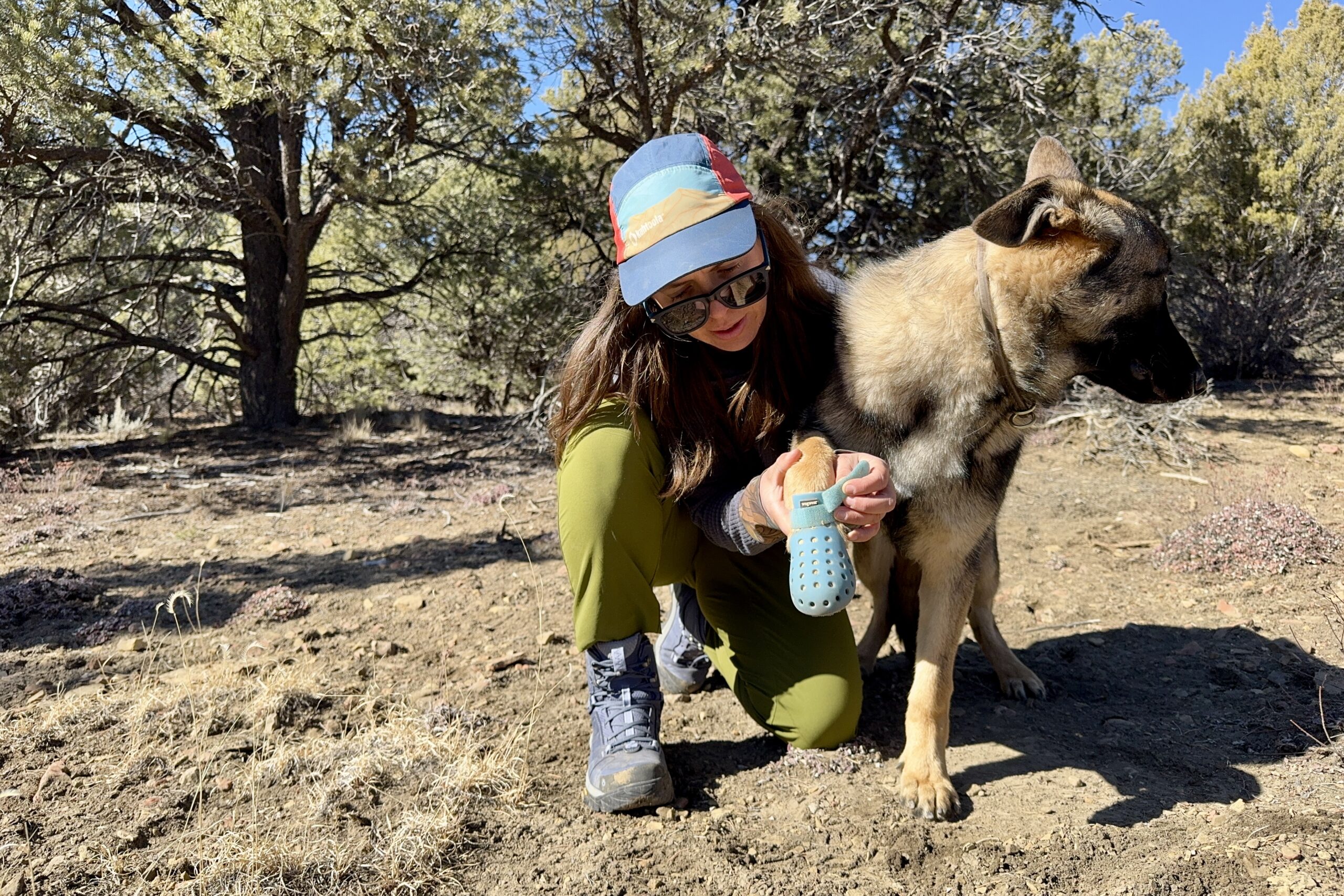
Should You Buy the WagWellies Mojave Dog Boots?
We love the WagWellies Mojave for how versatile they are. On the surface they appear to be ill suited to hiking, but we found that they held up really well when backpacking. We would absolutely use these boots on a thru-hike or just to take the dog out for a bathroom break on a hot summer day. These boots are not as ideal for the snow due to how open they are, but they can be paired with Wagwarmers or upgraded to the original WagWellies for cold weather. We would also be hesitant to use these boots for significant off trail hiking due to the perforated ventilation holes. However, they work great for use on single track trails.
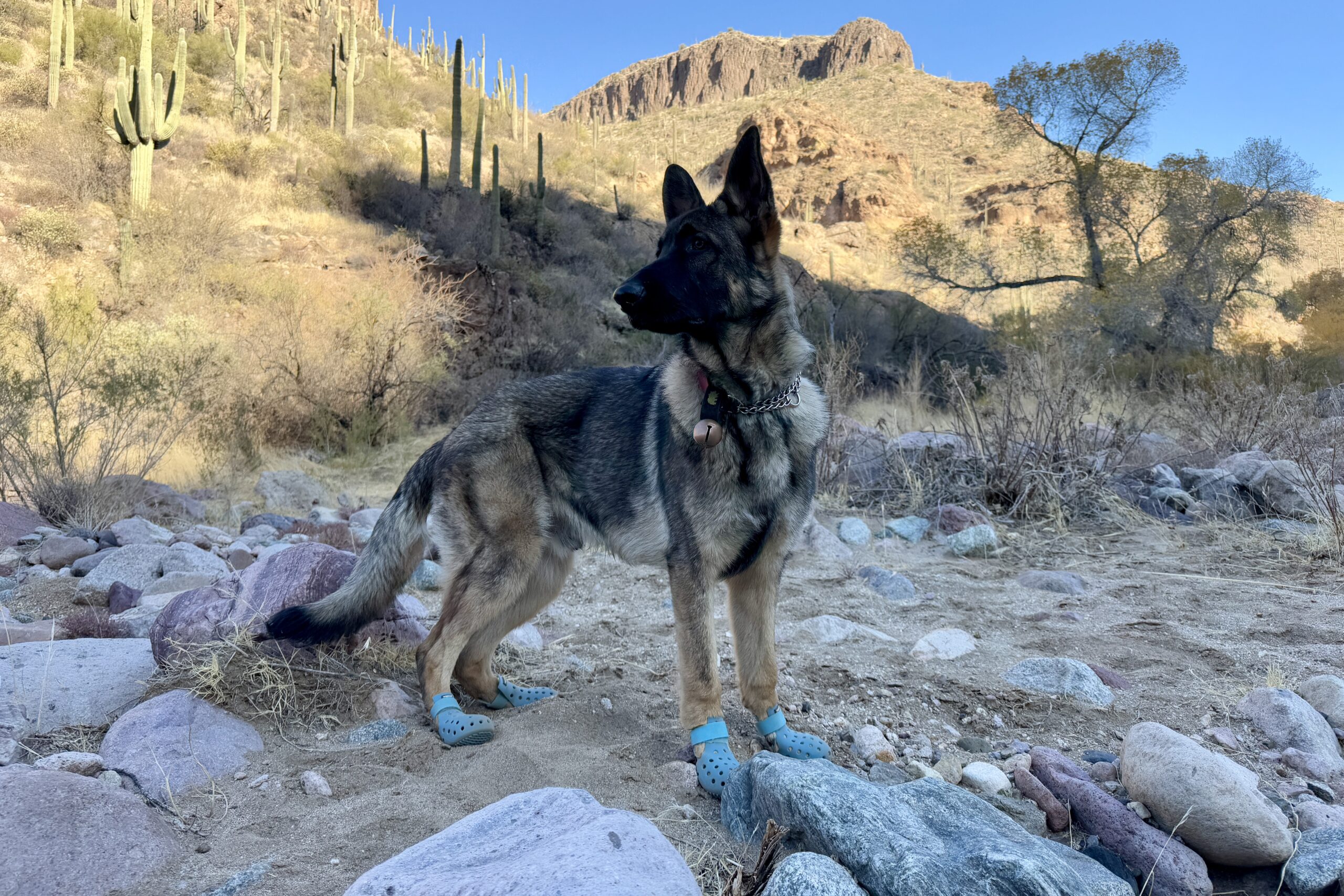
What Other Dog Boots Should You Consider?
We have tested plenty of dog boots over the years, and the WagWellies are certainly one of the most unique! However, you can see our full guide to dog boots for alternatives. Here are a few other options to consider:
Muttluks All Weather: The Muttluks All Weather boots blend many of the benefits of a rubber soled boot with the minimalistic qualities found in mushing models. Like the Mojave, these boots are high performers that trade a bit of durability and breathability for even better foot protection and ease of use.
Ruffwear Grip Trex: Made specifically for hiking, the Ruffwear Grip Trex has fantastic tread and great durability. We have used these boots on many trips, and they have shown that they can stand up to the elements.
Clawgs V3: For those who are looking to buy a rubber boot that does not inhibit the dew claw, the Clawgs V3 are a great option. The durability, protection, and traction qualities are not quite as good on these boots, but their build and strap allow for even more freedom for the dew claw.

The post Wagwear WagWellies Mojave Dog Boot Review appeared first on CleverHiker.


